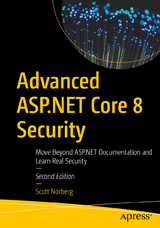
Advanced ASP.NET Core 3 Security
Apress (Verlag)
978-1-4842-6016-6 (ISBN)
- Titel erscheint in neuer Auflage
- Artikel merken
For straightforward use cases, the ASP.NET Core framework does a good job in preventing certain types of attacks from happening. But for some types of attacks, or situations that are not straightforward, there is very little guidance available on how to safely implement solutions. And worse, there is a lot of bad advice online on how to implement functionality, be it encrypting unsafely hard-coded parameters that need to be generated at runtime, or articles which advocate for certain solutions that are vulnerable to obvious injection attacks. Even more concerning is the functions in ASP.NET Core that are not as secure as they should be by default.
Advanced ASP.NET Core 3 Security is designed to train developers to avoid these problems. Unlike the vast majority of security books that are targeted to network administrators, system administrators, or managers, this book is targeted specifically to ASP.NET developers. Author Scott Norberg begins by teaching developers how ASP.NET Core works behind the scenes by going directly into the framework's source code. Then he talks about how various attacks are performed using the very tools that penetration testers would use to hack into an application. He shows developers how to prevent these attacks. Finally, he covers the concepts developers need to know to do some testing on their own, without the help of a security professional.
What You Will Learn
Discern which attacks are easy to prevent, and which are more challenging, in the framework
Dig into ASP.NET Core 3.1 source code to understand how the security services work
Establish a baseline for understanding how to design more secure software
Properly apply cryptography in software development
Take a deep dive into web security concepts
Validate input in a way that allows legitimate traffic but blocks malicious traffic
Understand parameterized queries and why they are so important to ASP.NET Core
Fix issues in a well-implemented solution
Know how the new logging system in ASP.NET Core falls short of security needs
Incorporate security into your software development process
Who This Book Is For
Software developers who have experience creating websites in ASP.NET and want to know how to make their websites secure from hackers and security professionals who work with a development team that uses ASP.NET Core. A basic understanding of web technologies such as HTML, JavaScript, and CSS is assumed, as is knowledge of how to create a website, and how to read and write C#. You do not need knowledge of security concepts, even those that are often covered in ASP.NET Core documentation.
Scott Norberg is a web security specialist with almost 15 years of experience in various technology and programming roles, focusing on developing and securing websites built with ASP.NET. As a security consultant, he specializes on blue team (defensive) techniques such as Dynamic Application Security Testing (DAST), code reviews, and manual penetration testing. He also has an interest in building plug-and-play software libraries that developers can use to secure their sites with little-to-no extra effort. As a developer, Scott has primarily built websites with C# and various versions of ASP.NET, and he has also built several tools and components using F#, VB.NET, Python, R, Java, and Pascal. Scott holds several certifications, including Microsoft Certified Technology Specialist (MCTS), certifications for ASP.NET and SQL Server, and a Certified Information Systems Security Professional (CISSP) certification. He also has an MBA from Indiana University. Scott is currently working as a contractor and consultant through his business, Norberg Consulting Group, LLC. You can see his latest ideas and projects at scottnorberg.com.
Chapter 1: Introducing ASP.NET Core.- Chapter 2: General Security Concepts.- Chapter 3: Cryptography.- Chapter 4: Web Security Concepts.- Chapter 5: Understanding Common Attacks.- Chapter 6: Processing User Input.- Chapter 7: Authentication and Authorization.- Chapter 8: Data Access and Storage. - Chapter 9: Logging and Error Handling.- Chapter 10: Setup and Configuration.- Chapter 11: Secure Application Life Cycle Management.
| Erscheinungsdatum | 09.11.2020 |
|---|---|
| Zusatzinfo | 30 Illustrations, black and white; XX, 405 p. 30 illus. |
| Verlagsort | Berkley |
| Sprache | englisch |
| Maße | 178 x 254 mm |
| Themenwelt | Informatik ► Netzwerke ► Sicherheit / Firewall |
| Mathematik / Informatik ► Informatik ► Software Entwicklung | |
| ISBN-10 | 1-4842-6016-3 / 1484260163 |
| ISBN-13 | 978-1-4842-6016-6 / 9781484260166 |
| Zustand | Neuware |
| Informationen gemäß Produktsicherheitsverordnung (GPSR) | |
| Haben Sie eine Frage zum Produkt? |
aus dem Bereich



